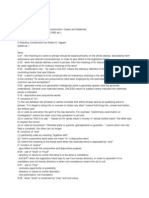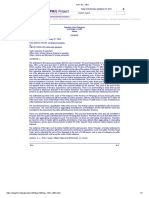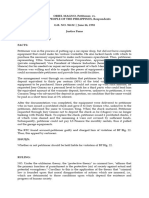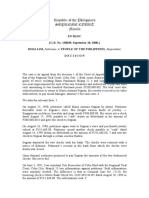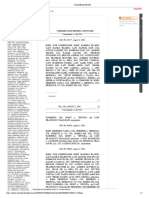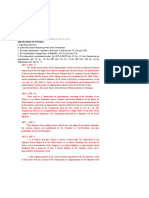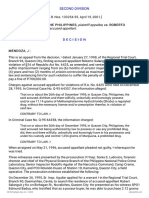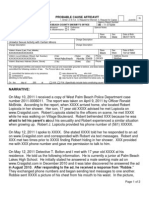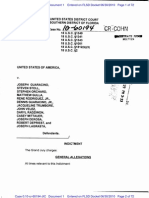Indeterminate Sentence Law
Indeterminate Sentence Law
Uploaded by
Vee DammeCopyright:
Available Formats
Indeterminate Sentence Law
Indeterminate Sentence Law
Uploaded by
Vee DammeOriginal Description:
Copyright
Available Formats
Share this document
Did you find this document useful?
Is this content inappropriate?
Copyright:
Available Formats
Indeterminate Sentence Law
Indeterminate Sentence Law
Uploaded by
Vee DammeCopyright:
Available Formats
Indeterminate Sentence Law (ISLAW): How to
determine maximum and minimum penalties
(Act no 4103 as amended)
The Indeterminate Sentence Law is mandatory in all cases, EXCEPT if the
accused will fall in any of the following exceptions:
1. if sentenced with a penalty of death or life imprisonment
2. if convicted of treason, conspiracy, proposal to commit treason
3. if convicted of misprision of treason, sedition, rebellion or espionage
4. if convicted of piracy
5. if the offender is a habitual delinquent
6. those who escaped from prison or evaded sentence
7. those who violated the terms of conditional pardon of the chief executive
8. where the maximum term of imprisonment does not exceed 1 year
(important!)
9. if convicted by final judgement at the time of the effectivity of Act No.
4103
10. if penalized with suspension or destierro
If accused fall in any of the foregoing exceptions. DO NOT APPLY ISLAW!
ISLAW applies to offenses punished by Special Law and Revised Penal
Code.
Why is ISLAW mandatory?
In the application of the Indeterminate Sentence Law the judge will get the
maximum penalty and likewise the minimum penalty. If the accused was
already able to serve the minimum term of his indeterminate sentence and
upon the approval of the Board, the accused now becomes eligible for
parole. ISLAW is favorable to the accused.
If the accused was granted parole and violated some conditions of the
parole, What will happen?
A warrant of arrest will be issued by the court and the accused will be made
to serve the rest of the remaining or unexpired portion of his sentence. (But
in probation you go back to number 1, serving of sentence will be from the
beginning)
Application of ISLAW:
How to get maximum and minimum penalty in Special Law:
1. The maximum penalty should NOT exceed the maximum provided for by
that law.
2. The minimum penalty should NOT fall below the minimum provided by
the law.
How to get maximum and minimum penalty in Revised Penal Code:
Example: In the crime of homicide, under the Revised Penal Code, the
offender is sentenced to reclusion temporal.
The maximum penalty under the Indeterminate Sentence Law is reclusion
temporal. But reclusion temporal is a divisible penalty consisting of
maximum, medium and minimum periods. Which period will we place the
maximum term of the Indeterminate Sentence?
Guide for determining the maximum penalty:
1. Determine the entire range of the penalty
2. Determine if there is mitigating or aggravating circumstance
Which period will the maximum penalty be placed?
In pursuant to art 64, when there is no mitigating and no aggravating
circumstance, it should be placed at the medium period. Thus, the maximum
penalty for the example above is reclusion temporal in the medium period.
What is the minimum penalty now?
In getting the minimum penalty, the rule is to simply get the penalty one (1)
degree lower from the maximum penalty without taking into account the
mitigating and aggravating circumstance. Thus, the penalty one degree
lower from reclusion temporal, without taking into account any mitigating or
aggravating circumstance, is prision mayor. Prision mayor is now the
minimum penalty for our example.
Important: If your maximum penalty is wrong, it follows that the minimum
penalty will also be wrong.
Again, prision mayor is a divisible penalty. Which period can it be placed?
Under the Indeterminate Sentence Law, it would depend upon the
discretion of the court on which period to place it. Thus, the minimum
penalty is prision mayor in any of its period.
Factors that could affect the imposition of minimum penalty:
1. Age
2. Conduct during trial
3. Mental or physical condition
Suppose in the example above, 1 aggravating circumstance was proven.
What is now the maximum penalty?
It would still be reclusion temporal, but it shall be placed in the maximum
period because of the presence of 1 aggravating circumstance.
How about the minimum penalty?
It would still be 1 degree lower from reclusion temporal, which is prision
mayor. In which period? It shall be discretionary upon the court.
(More examples)
1 mitigating but NO aggravating
maximum penalty: reclusion temporal in the minimum period
minimum penalty: prision mayor in any period
2 mitigating, NO aggravating (privileged mitigating)
maximum penalty: prision mayor in the medium period
minimum penalty: prision correctional any period
The preceding example is an exception to the rule. If there is a privileged
mitigating circumstance, we take it into account first in order to obtain the
proper maximum penalty. Then, from that maximum penalty, we obtain the
proper minimum penalty by getting the penalty 1 degree lower. Same rule
applies as to the period of the minimum penalty.
Remember: It will never become a privileged mitigating circumstance if
there is an aggravating circumstance present. 8 mitigating and 1
aggravating will never become privileged mitigating circumstance.
3 mitigating, NO aggravating
maximum penalty: prision mayor in the minimum period
minimum penalty: prision correctional any period
In the preceding example, there are 3 mitigating circumstance present and
no aggravating circumstance. The first two mitigating circumstance shall be
a privileged mitigating circumstance. Thus, the penalty will be reduced by 1
degree from reclusion temporal to prision mayor. The 3rd mitigating
circumstance shall place the penalty in the minimum period.
4 mitigating, NO aggravating
maximum penalty: prision correctional in the medium period (2 privileged
circumstance. Thus we lower by 2 degrees)
minimum penalty: arresto mayor any period
5 mitigating, NO aggravating
maximum penalty: prision correctional in the minimum period
minimum penalty: arresto mayor any period
At most we can only lower by 2 degrees. Thus, if there are 6 mitigating
circumstance and NO aggravating:
maximum penalty: prision correctional in the minimum period
minimum penalty: arresto mayor any period
How is Indeterminate Sentence Law applied in complex crimes
(Article 48)?
A complex crime is punished by the most serious offense and shall be
imposed in its maximum period.
Example: Estafa through falsification of public documents.
Under the Revised Penal Code, falsification of public documents (Article
171) is a more serious offense punished by prision mayor than estafa (Article
315), punished only by prision correctional.
Thus, applying the Indeterminate Sentence Law, the maximum penalty for
estafa through falsification of public documents shall be prision mayor in the
maximum period. Minimum penalty shall be prision correctional, any period.
Suppose there was 1 mitigating circumstance proven. Maximum penalty
would still be prision mayor in the maximum period. In pursuant to Article 48,
even if there is a mitigating circumstance present, it should still be imposed
at the maximum period.
How about if there are 2 mitigating circumstance and no aggravating?
The rule is, if it is a privileged mitigating circumstance, we lower by the
penalty by one degree but still place it at the maximum period. Thus, the
maximum penalty shall be prision correctional in the maximum period.
4 mitigating, NO aggravating
maximum penalty: arresto mayor in its maximum period
You might also like
- Indeterminate Sentence LawDocument4 pagesIndeterminate Sentence LawMark Gregory SalayaNo ratings yet
- Statcon 8.13Document3 pagesStatcon 8.13Em Asiddao-DeonaNo ratings yet
- Atty. Alex Andrew P. Icao Statutory Construction Course OutlineDocument5 pagesAtty. Alex Andrew P. Icao Statutory Construction Course OutlineKaren K. GaliciaNo ratings yet
- Statcon Case 28 DigestDocument2 pagesStatcon Case 28 DigestIan RonquilloNo ratings yet
- US v. Punsalan PDFDocument1 pageUS v. Punsalan PDFdats_idji100% (1)
- Article XVI - Docx1987 ConstiDocument3 pagesArticle XVI - Docx1987 Constiarellano lawschoolNo ratings yet
- Digest - People v. FerrerDocument2 pagesDigest - People v. FerrerDae JosecoNo ratings yet
- G.R. No. 112019Document3 pagesG.R. No. 112019jbandNo ratings yet
- Soliven vs. Judge Makasiar-167 Scra 393Document1 pageSoliven vs. Judge Makasiar-167 Scra 393kai lumagueNo ratings yet
- ABC of Remedial LawDocument6 pagesABC of Remedial LawAbigail Talosig BarandinoNo ratings yet
- REVUP Notes in Criminal LawDocument28 pagesREVUP Notes in Criminal LawAndrea Klein LechugaNo ratings yet
- Penalties Crim Law 1Document6 pagesPenalties Crim Law 1CatherineNo ratings yet
- People vs. Puno, 219 SCRA 85Document3 pagesPeople vs. Puno, 219 SCRA 85LifelessStar -No ratings yet
- The Executive DepartmentDocument3 pagesThe Executive DepartmentVivian NiñonNo ratings yet
- People V Patricio Amigo Alias BEBOTDocument1 pagePeople V Patricio Amigo Alias BEBOTAprille S. AlviarneNo ratings yet
- Poli Law ReviewerDocument5 pagesPoli Law ReviewerDenn Reed Baring Tuvera Jr.No ratings yet
- Constitutional Law I Short ReviewDocument4 pagesConstitutional Law I Short ReviewPablo Lorenzo BenedictoNo ratings yet
- San Beda College of Law: 1 M A L E P EDocument29 pagesSan Beda College of Law: 1 M A L E P ECassie GacottNo ratings yet
- de Guzman vs. Subido, 120 SCRA 443Document6 pagesde Guzman vs. Subido, 120 SCRA 443Joanna Loi Caceres AbayaNo ratings yet
- Republic of The Philippines v. Daisy R. Yahon, G.R. No. 201043, June 16, 2014Document10 pagesRepublic of The Philippines v. Daisy R. Yahon, G.R. No. 201043, June 16, 2014Mary ruth DavidNo ratings yet
- Chapt. 1-3Document15 pagesChapt. 1-3Jarvin David ResusNo ratings yet
- Case Title GR No. Date of Decision Ponente Legal Basis: Tañada v. Tuvera L - 63915 April 24, 1985Document1 pageCase Title GR No. Date of Decision Ponente Legal Basis: Tañada v. Tuvera L - 63915 April 24, 1985Cearl Bush LasquiteNo ratings yet
- Case1 Tañada & Macapagal vs. Cuenco Et. AlDocument6 pagesCase1 Tañada & Macapagal vs. Cuenco Et. AlArchie CarlosNo ratings yet
- Aquino JR Vs Military Commission 2Document1 pageAquino JR Vs Military Commission 211 : 28No ratings yet
- Francisco vs. HREPDocument3 pagesFrancisco vs. HREPCharnemNo ratings yet
- Caudal v. CA GR 83414, July 31, 1989Document6 pagesCaudal v. CA GR 83414, July 31, 1989Michael SherwinNo ratings yet
- People Vs Fernandez G.R. No. L-62116 1990Document3 pagesPeople Vs Fernandez G.R. No. L-62116 1990Rodolfo TobiasNo ratings yet
- G.R. No. 4963 (US V Go Chico)Document5 pagesG.R. No. 4963 (US V Go Chico)KhiarraNo ratings yet
- Community Service ActDocument1 pageCommunity Service Actkero keropiNo ratings yet
- ALLIANCE FOR NATIONALISM AND DEMOCRACY (ANAD) vs. COMMISSION ON ELECTIONSDocument1 pageALLIANCE FOR NATIONALISM AND DEMOCRACY (ANAD) vs. COMMISSION ON ELECTIONSRochelle GablinesNo ratings yet
- BAR EXAMINATION 2006 - PoliticalandPublicInternationalLawDocument10 pagesBAR EXAMINATION 2006 - PoliticalandPublicInternationalLawLyraNo ratings yet
- Final Examination - Basic Legal and Judicial EthicsDocument5 pagesFinal Examination - Basic Legal and Judicial EthicsCecille DiazNo ratings yet
- Case Digest - Magno VS CaDocument2 pagesCase Digest - Magno VS Cadawnybalezlaw23No ratings yet
- How Are Felonies CommittedDocument4 pagesHow Are Felonies CommittedErnuel PestanoNo ratings yet
- Lim vs. People of The Philippines, 340 SCRA 497Document5 pagesLim vs. People of The Philippines, 340 SCRA 497Chanyeol ParkNo ratings yet
- Lopez V CA, GR No 144573Document1 pageLopez V CA, GR No 144573Micah DeleonNo ratings yet
- Article Vi Basic ConceptsDocument46 pagesArticle Vi Basic Conceptskatrinagay visitacionNo ratings yet
- Domino v. Comelec G.R. No. 134015 July 19, 1999Document15 pagesDomino v. Comelec G.R. No. 134015 July 19, 1999Maritoni RoxasNo ratings yet
- Comendador vs. de VillaDocument1 pageComendador vs. de VillaBeng ChiongNo ratings yet
- Constitutional Law 2 - Fundamental Powers of The State With CasesDocument11 pagesConstitutional Law 2 - Fundamental Powers of The State With CasesRn-jd Sui GenerisNo ratings yet
- ARTICLE VIII Judicial DepartmentDocument1 pageARTICLE VIII Judicial DepartmentLizzy WayNo ratings yet
- The Law Student Digest - STATUTORY CONSTRUCTION REVIEWER - AGPALODocument11 pagesThe Law Student Digest - STATUTORY CONSTRUCTION REVIEWER - AGPALOJose Cristobal LiwanagNo ratings yet
- Comendador Et Al vs. de Villa Et AlDocument9 pagesComendador Et Al vs. de Villa Et AlD MonioNo ratings yet
- Ejusdem Generis Real HandoutDocument1 pageEjusdem Generis Real HandoutLoury LuzadioNo ratings yet
- Jema ReqsDocument11 pagesJema ReqsMartian MaraeNo ratings yet
- Statcon CasesDocument32 pagesStatcon CasesJennelie jandusayNo ratings yet
- Pharmaceutical and Health Care Association of The Philippines VsDocument4 pagesPharmaceutical and Health Care Association of The Philippines VsALEXANDRIA RYLE MUNARNo ratings yet
- People Vs Tiongson Rule 121Document2 pagesPeople Vs Tiongson Rule 121Czara DyNo ratings yet
- Chapter V Notes AgpaloDocument18 pagesChapter V Notes AgpaloAliya Safara AmbrayNo ratings yet
- G.R. No. L-23052 - City of Manila v. TeoticoDocument5 pagesG.R. No. L-23052 - City of Manila v. TeoticoKris AlarinNo ratings yet
- People v. MadarangDocument2 pagesPeople v. MadarangMariel RamirezNo ratings yet
- Midterm SeparationDocument23 pagesMidterm Separationlouis jansen100% (1)
- Emilio A. Gonzales III v. Office of The President, Etc., Et Al GR 196231 & Wendell Bareras-Sulit v. Atty. Paquito N. Ochoa, JR., Et Al. GR 196232Document50 pagesEmilio A. Gonzales III v. Office of The President, Etc., Et Al GR 196231 & Wendell Bareras-Sulit v. Atty. Paquito N. Ochoa, JR., Et Al. GR 196232Ronald Allan Moreno100% (1)
- Constitutional Law IDocument90 pagesConstitutional Law IDarwin BonifacioNo ratings yet
- Gatchalian v. COMELEC, GR No. 32560, 22 October 1970Document4 pagesGatchalian v. COMELEC, GR No. 32560, 22 October 1970Judy Anne RamirezNo ratings yet
- Amores vs. HretDocument5 pagesAmores vs. HretMitch LimNo ratings yet
- Unfair Labor Practices 258-260Document10 pagesUnfair Labor Practices 258-260Enric AlcaideNo ratings yet
- Vargas vs. Rilloraza, GR L-1612Document1 pageVargas vs. Rilloraza, GR L-1612Baisy VillanozaNo ratings yet
- 4 People VS VillacorteDocument8 pages4 People VS VillacorteJudy Ann MaderazoNo ratings yet
- Challenges and alternatives towards peacebuilding: A rural development perspectiveFrom EverandChallenges and alternatives towards peacebuilding: A rural development perspectiveNo ratings yet
- TTX Human Trafficking With ANSWERS For DavaoDocument7 pagesTTX Human Trafficking With ANSWERS For DavaoVee DammeNo ratings yet
- ORGANIZATIONAL STRUCTURE of Rattf 9Document2 pagesORGANIZATIONAL STRUCTURE of Rattf 9Vee DammeNo ratings yet
- Ra 10364 Mine Dec 2014Document80 pagesRa 10364 Mine Dec 2014Vee DammeNo ratings yet
- Philippine Laws On WomenDocument10 pagesPhilippine Laws On WomenVee DammeNo ratings yet
- FINALS InstitutionalDocument20 pagesFINALS InstitutionalpartaannannNo ratings yet
- Crim CaseDocument33 pagesCrim CaseJoscine RodneyNo ratings yet
- Acpoguidance - Investigating Child Abuse2009Document197 pagesAcpoguidance - Investigating Child Abuse2009FloraReichNo ratings yet
- Minnesota Financial Crimes Task Force Legislative Report 2017Document8 pagesMinnesota Financial Crimes Task Force Legislative Report 2017Beverly TranNo ratings yet
- 114633-2001-People v. Salanguit y KoDocument12 pages114633-2001-People v. Salanguit y KoChristian VillarNo ratings yet
- Criminal Prac Assgn No. 2 2023 2024Document2 pagesCriminal Prac Assgn No. 2 2023 2024Shamar TomlinsonNo ratings yet
- CA 1 Institutional Correction SyllabusDocument10 pagesCA 1 Institutional Correction Syllabuszamoramc.2022No ratings yet
- PC Rob Lopicola #2Document2 pagesPC Rob Lopicola #2Sergio Nahuel CandidoNo ratings yet
- Multimedia Presentation On Homicide Detectives For The City of Miami Police DepartmentFinalDocument15 pagesMultimedia Presentation On Homicide Detectives For The City of Miami Police DepartmentFinalMandelaNo ratings yet
- English: Law and RegulationsDocument11 pagesEnglish: Law and RegulationsClaire TsaoNo ratings yet
- People of The Philippines vs. Hon. Bonifacio Sanz MacedaDocument3 pagesPeople of The Philippines vs. Hon. Bonifacio Sanz MacedaJanet Tal-udanNo ratings yet
- Leon County Booking Report: April 4, 2021Document2 pagesLeon County Booking Report: April 4, 2021WCTV Digital TeamNo ratings yet
- Code of Criminal Procedure SLDocument209 pagesCode of Criminal Procedure SLSenuri DesilvaNo ratings yet
- Riza - CV InterpretingDocument3 pagesRiza - CV Interpretingriza aries setyawanNo ratings yet
- Booking Report 8-26-2020Document3 pagesBooking Report 8-26-2020WCTV Digital TeamNo ratings yet
- Should We Defund The Police?: - Nicholas SmithDocument10 pagesShould We Defund The Police?: - Nicholas SmithWlr DiorNo ratings yet
- Basic Policing in EnglandDocument32 pagesBasic Policing in Englandardikurniawan2005No ratings yet
- Human Rights Violation by Police in IndiaDocument18 pagesHuman Rights Violation by Police in IndiaNitisha GeedNo ratings yet
- Parent ConsentDocument16 pagesParent Consentdeborah matadosNo ratings yet
- SAO Memo On Sheriff Darryl DanielsDocument2 pagesSAO Memo On Sheriff Darryl DanielsAnne Schindler100% (1)
- Police Community RelationsDocument4 pagesPolice Community Relationsapi-553174574No ratings yet
- No Place For Kids: The Case For Reducing Juvenile IncarcerationDocument51 pagesNo Place For Kids: The Case For Reducing Juvenile IncarcerationAJ WoodsonNo ratings yet
- Correctional Administration2Document8 pagesCorrectional Administration2Jeron Bert D. Agustin100% (3)
- (U) Daily Activity Report: Marshall DistrictDocument5 pages(U) Daily Activity Report: Marshall DistrictFauquier NowNo ratings yet
- Dakota County Attorney James Backstrom On Deadly Police ShootingDocument7 pagesDakota County Attorney James Backstrom On Deadly Police ShootingPatch MinnesotaNo ratings yet
- 21-049664 Incident ReportDocument3 pages21-049664 Incident ReportJeremy TurnageNo ratings yet
- Current RosterDocument8 pagesCurrent RosterDarin ThomasNo ratings yet
- Poli Art 3 Sec 12-14Document6 pagesPoli Art 3 Sec 12-14Maria Lea Bernadeth OticoNo ratings yet
- Plantation Police Officers Mortgage Fraud Indictment.Document72 pagesPlantation Police Officers Mortgage Fraud Indictment.The Straw BuyerNo ratings yet
- Week 3 - DigestsDocument4 pagesWeek 3 - DigestsVhinj CostillasNo ratings yet

